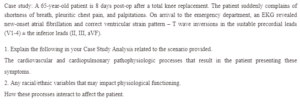Cardiovascular and Respiratory Systems
Total knee replacement is a surgical procedure, referred to as knee arthroplasty, performed to replace a knee joint with artificial material. The process is performed when there is severe knee joint pain or decreased function due to osteoarthritis or rheumatoid arthritis. Although total knee replacement is usually successful, it is associated with different complications, including infections, pulmonary embolism, dislocation, bone fracture, pain, and nerve and tissue damage. This paper analyzes a case of a patient who developed signs and symptoms related to the complications of total knee replacement.
The patient complained of shortness of breath, pleuritic chest pains, and palpitations. These symptoms are likely to have been manifestations of pulmonary embolism. Pulmonary embolism could have occurred in the patient as a complication of deep vein thrombosis caused by the surgery. Patients are commonly affected by deep vein thrombosis weeks to days after surgery (Erickson et al., 2017). Deep vein thrombosis affects them due to their inactivity after surgery. In deep vein thrombosis, a blood clot forms in a deep vein in the body. The most common site of deep vein thrombosis is in the legs (Dua et al., 2017). The blood clot formed, leading to deep vein thrombosis, can move through the blood to other body parts. When it moves to the lungs, it can lead to pulmonary embolism. In pulmonary embolism, blood flow to the lung is blocked by a blood clot in an artery in the lung. The clot can lodge at the bifurcation of the pulmonary artery, leading to pulmonary embolism. Pulmonary embolism presents with shortness of breath, palpitations, pleuritic chest pain, wheezing, and tachycardia. Therefore, the patient was experiencing shortness of breath, pleuritic chest pain, and vibrations due to pulmonary embolism.
The patient also presented with atrial fibrillation and a correct ventricular strain pattern. Different factors cause atrial fibrillation after a surgical procedure. It can occur due to hypothermia, hypovolemia, infection (pneumonia, sepsis), hypoxia (atelectasis, obstructive sleep apnea, pulmonary embolism), electrolyte imbalance (hypomagnesemia, hypokalemia), and uncontrolled pain (Gould et al., 2020). For this patient, atrial fibrillation is likely to have been caused by pulmonary embolism. Pulmonary embolism can cause right ventricular dilatation with strain, leading to atrial fibrillation. Besides, pulmonary embolism can lead to slow conduction by causing myocardial ischemia to the atrioventricular node. This is manifested as a correct ventricular strain pattern in the EKG, as seen in the patient.
Genetic variations among different races predispose individuals to certain conditions. Genes such as factor V Leiden and prothrombin gene have shown variation among other races. They are more common among Caucasians than Asians or African Americans. Since the presence of the genes predisposes individuals to deep vein thrombosis, the prevalence of deep vein thrombosis among Caucasians is higher than in Asians or Americans (Romano et al., 2020). Therefore, some races predispose patients to deep vein thrombosis.
In the patient, there is a likelihood that he developed a thrombus in the deep veins, which moved to the lungs, causing pulmonary embolism. However, he needed to be assessed to determine whether his race has either the prothrombin gene or factor V Leiden. The presence of the genes in his body could have predisposed him to deep vein thrombosis, which later led to pulmonary embolism. This implies that determining one’s race before a surgical procedure could help prevent such complications.
All in all, the patient experienced symptoms of pulmonary embolism, which could have developed due to deep vein thrombosis. A blood clot could have accessed the lungs through the circulation, causing the signs he was experiencing. The EKG shows that pulmonary embolism could cause atrial fibrillation and right ventricular strain. Factor V Leiden or the prothrombin gene could predispose the patient to deep vein thrombosis.
Need help with your assignment? Get in touch with us at eminencepapers.com.
References
Dua, A., Desai, S. S., Lee, C. J., & Heller, J. A. (2017). National Trends in Deep Vein Thrombosis Following Total Knee and Total Hip Replacement in the United States. Annals of Vascular Surgery, 38, 310–314. https://doi.org/10.1016/j.avsg.2016.05.110
Erickson, B. J., Tilton, A., Frank, R. M., Park, W., & Cole, B. J. (2017). Rates of Deep Vein Thrombosis Occurring After Osteotomy About the Knee. American Journal of Orthopedics (Belle Mead, N.J.), 46(1), E23–E27.
Gould, D., Dowsey, M., Jo, I., & Choong, P. (2020). Patient-related risk factors for unplanned 30-day readmission following total knee arthroplasty: a narrative literature review. ANZ Journal of Surgery, 90(7–8), 1253–1258. https://doi.org/10.1111/ans.15695
Romano, A. V. C., Barnabé, A., Gadelha, T. B., Guerra, J. C. de C., Secolin, R., Orsi, F. L. de A., Campanate, G. de C. S., Wolosker, N., & Annichino-Bizzacchi, J. M. (2020). Gene Variants Associated With Venous Thrombosis: A Replication Study in a Brazilian Multicentre Study. Clinical and Applied Thrombosis/Hemostasis, 26. https://doi.org/10.1177/1076029620962225
ORDER A PLAGIARISM-FREE PAPER HERE
We’ll write everything from scratch
Question

Cardiovascular and Respiratory Systems
Case study: A 65-year-old patient is eight days post-op after a total knee replacement. The patient suddenly complains of shortness of breath, pleuritic chest pain, and palpitations. On arrival to the emergency department, an EKG revealed new-onset atrial fibrillation and correct ventricular strain pattern – T wave inversions in the suitable precordial leads (V1-4) ± the inferior leads (II, III, aVF).
- Explain the following in your Case Study Analysis related to the scenario provided.
The cardiovascular and cardiopulmonary pathophysiologic processes that result in the patient presenting these symptoms. - Any racial/ethnic variables that may impact physiological functioning.
How these processes interact to affect the patient.


